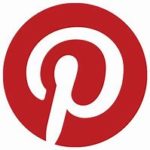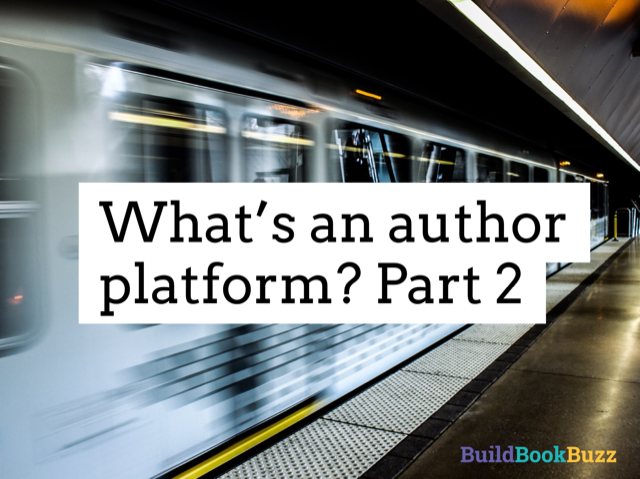What’s an author platform? Part 2
In “What’s an author platform? Part 1,” we defined author platform and why it’s important.
It’s what you’ve done to make sure you have an audience waiting to buy your book.
The more you’ve done, the stronger your platform. A strong platform will make you more attractive to a publisher, but even if self-publishing is your best option, you still need that platform. You want an audience waiting for your book.
No audience = no sales.
12 author platform building blocks
But how do you build that essential platform?
Here are 12 building blocks to consider for your platform’s support, but before you think, “TWELVE? How can I do all that?“, understand that you only need a few of them.
Your platform should be built on the right elements; not everything in this list makes sense for you and your target readers. If you won’t reach your audience with one of them (for example, your readers might not be on Twitter), then cross that building block off your list of options.
Focus on the pieces that are right for your book and its readers, not anyone else’s.
1. E-mail list and newsletter subscribers.
How many e-mail addresses do you have, but more importantly, how many of them are in your book’s target market? Offer a free gift on your website – the first chapter of your book, a downloadable audio interview, a cheat sheet – in exchange for a name and e-mail address. It’s important to keep your name and topic in front of the people who are most likely to buy your book; a regular e-mail newsletter is an excellent way to do that. Make it useful, not promotional, so that people look forward to reading and sharing it.
2. Online group members.
While LinkedIn undermines its groups, Facebook groups are gaining steam. No matter where it’s hosted, an online group for your book’s topic or genre will help you learn more about your readers and what they want and need. As with everything else, the more members you have in your group, the more that group will add to your platform. (By the way, please join the Build Book Buzz Facebook group to talk all things book marketing!)
3. Media interviews and media outlets that publish what you write.
Get interviewed by the press, get copies of those interviews, and create a database with the contact information for the journalists who interviewed you. You’ll want the clips, audio links, etc., for your book proposal and you’ll need the database to create a book publicity media mailing list.
Offline and online media outlets that regularly run your articles, videos, and so on will be more open to collaborating on book promotion. A regular column that reaches your book’s target audience is a big plus.
 4. Instagram followers.
4. Instagram followers.
If your target audience is younger, Instagram is where it’s at for you and your book. Almost two-thirds of its users are under 30. And they are definitely sharing what they read there. Learn how author Kate Hanley does it in “How I use Instagram to sell more books.”
 5. Pinterest followers.
5. Pinterest followers.
If your book relates to women’s lifestyles — cooking, decorating, crafting, and so on — make sure you’re getting images up on Pinterest. It’s dominated by women who use it to archive and share what they like — including books on these and other topics.
 6. Twitter followers.
6. Twitter followers.
If you’re self-publishing, you’ll want quality, not quantity. If you’re hoping to get a contract with a traditional publisher, editors appear to be more interested in quantity than quality (sigh), so go for volume. (But understand that if your book is about the mating habits of Icelandic penguins, those 68 social media consultants who follow you aren’t going to buy your book.)
 7. Facebook fan page likers/fans.
7. Facebook fan page likers/fans.
You don’t need a completed book to create a fan page for it. Post content that gets followers involved and engaged. Invite your fans to bring other fans along, too. Run contests to get more likes.
8. Speaking engagements.
A while back, an editor reviewing my book proposal asked for a list of speaking engagements for the previous and coming years along with the audience size for each. This level of detail helps publishers estimate how many books they can sell – and whether they think they can sell enough. If you’re a speaker who writes, you’re on more solid ground here than a writer who speaks.
9. A blog plus subscribers and traffic.
I’m surprised at the number of bloggers who don’t make it possible for visitors to receive their blog postings by e-mail or RSS feed. They’re missing the opportunity to generate repeat traffic – and to measure their fan base. Google Analytics and other tools and resources help measure traffic volume, too, but a truer measure of your fan base is that list of people who sign up to receive more of your content.
10. Industry leadership.
This not only reinforces your expert status, it also means that industry organizations will be more likely to share information about your book. They might even sell it.
11. Influential contacts.
A favorable testimonial (called a “blurb”) from a recognized expert or thought leader, especially one who is willing to recommend your book to her networks, is almost priceless. Several of these? Golden!
12. Popular YouTube channel.
YouTube is the second most popular search engine. That alone tells you that people watch YouTube videos. But if you need numbers to convince you, understand that more than 1 billion people use YouTube.
How many platform building blocks do you need?
How many of these building blocks do you need to support your platform?
That depends – on your book’s topic, the size of the market for it, and how that particular audience seeks/gets information.
A porch or deck has at least four supports — one in each corner — and sometimes more. The more of the right elements you have in your platform, the better positioned you will be to sell more books to the people who will love them.
What’s holding up your author platform? What building blocks do you have in place?
(Editor’s note: This article was first published in February 2012. It has been updated and expanded.)
Like what you’re reading? Get it delivered to your inbox every week by subscribing to the free Build Book Buzz newsletter. You’ll also get my free “Top 5 Free Book Promotion Resources” cheat sheet immediately!


Helpful information. Thanks.
Thanks again, Sandy. Very useful info…clear and concise. You definitely practice what you preach…and always provide valuable content. Love the analogy of the stool that needs at least 3 “legs” to stand on. 🙂
Thanks, Richard and Vivian. I appreciate the feedback!
Timely to read your blogs on building a platform, Sandra, as I have just posted this morning on my writer’s blog about using social media to build that coveted “author’s platform.”
I’ve been working at it for 3 years now, and am still told that my platform isn’t quite big enough for the type of book I am marketing (about to write.)
I do admit I enjoy engaging with people as I’m an outgoing individual, but wow! It sure takes time to have a noteworthy presence on social media.
I think the days of an e-newsletter are gone. Why bother with that when you have a blog?
Doreen,
I agree with your comment on the “Mystical Author’s Platform”. I have worked at it for a year and I am disappointed at the results for the effort involved.
Thanks, Doreen. I don’t agree with you about a newsletter — it doesn’t serve the same purpose as a blog. But that’s a whole ‘nother conversation.
Such excellent clarity and detail on a topic that has so often been presented as a somewhat “squishy” concept. It’s too important to be allowed to wallow in that squishiness, so thanks for nailing down the specifics of what makes a solid author platform. As with all your great information, so very helpful. And I have to agree that e-newsletters are far from “gone” — after all, that’s how I found you! THANKS!
Thanks, Mary! It is a “squishy” concept, isn’t it? I think a key point here is that if doesn’t matter if you go the traditional publishing route or if you self-publish — you still need to have an audience waiting to buy your book.
I’m glad to see you agree with me on the value of newsletters. They serve a different purpose from blogs. That might make a good blog topic, eh?
Thanks for stopping by, Mary. You know I always love hearing from you!
Sandy
Great article. Thanks.
Thanks, Ramona. You’re welcome.
Sandy